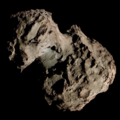 Comet Wild 1 taken from the Palomar Transient Factory on 4 April 2013 | |
| Discovery [1] | |
|---|---|
| Discovered by | Paul Wild |
| Discovery site | Zimmerwald Observatory, Switzerland |
| Discovery date | 26 March 1960 |
| Designations | |
| P/1960 G1 P/1973 A2 | |
| Wild 1 1960b, 1973c 1960 I, 1973 VIII [2] | |
| Orbital characteristics [3] | |
| Epoch | 1 March 2014 (JD 2456717.5) |
| Observation arc | 19,491 days (53.36 years) |
| Number of observations | 1,948 |
| Aphelion | 9.2249 AU |
| Perihelion | 1.9506 AU |
| Semi-major axis | 5.5877 AU |
| Eccentricity | 0.65092 |
| Orbital period | 13.21 years |
| Inclination | 19.780° |
| 358.002° | |
| Argument of periapsis | 169.030° |
| Last perihelion | 10 April 2013 |
| Next perihelion | 6 July 2026 [4] |
| TJupiter | 2.412 |
| Earth MOID | 0.9603 AU |
| Jupiter MOID | 1.3067 AU |
| Physical characteristics [3] [5] | |
| Dimensions | 2.9 km (1.8 mi) |
| 0.04 | |
| (V–R) = 0.50±0.05 | |
| Comet total magnitude (M1) | 6.5 |
| Comet nuclear magnitude (M2) | 14.3 |
63P/Wild is a periodic comet in the Solar System with a current orbital period of 13.21 years. It will next come to perihelion on 6 July 2026.

